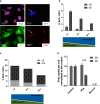3D culture conditions support Kaposi's sarcoma herpesvirus (KSHV) maintenance and viral spread in endothelial cells
- PMID: 33484281
- PMCID: PMC7900040
- DOI: 10.1007/s00109-020-02020-8
3D culture conditions support Kaposi's sarcoma herpesvirus (KSHV) maintenance and viral spread in endothelial cells
Abstract
Kaposi's sarcoma-associated herpesvirus (KSHV) is a human tumorigenic virus and the etiological agent of an endothelial tumor (Kaposi's sarcoma) and two B cell proliferative diseases (primary effusion lymphoma and multicentric Castleman's disease). While in patients with late stage of Kaposi's sarcoma the majority of spindle cells are KSHV-infected, viral copies are rapidly lost in vitro, both upon culture of tumor-derived cells or from newly infected endothelial cells. We addressed this discrepancy by investigating a KSHV-infected endothelial cell line in various culture conditions and in tumors of xenografted mice. We show that, in contrast to two-dimensional endothelial cell cultures, KSHV genomes are maintained under 3D cell culture conditions and in vivo. Additionally, an increased rate of newly infected cells was detected in 3D cell culture. Furthermore, we show that the PI3K/Akt/mTOR and ATM/γH2AX pathways are modulated and support an improved KSHV persistence in 3D cell culture. These mechanisms may contribute to the persistence of KSHV in tumor tissue in vivo and provide a novel target for KS specific therapeutic interventions. KEY MESSAGES: In vivo maintenance of episomal KSHV can be mimicked in 3D spheroid cultures 3D maintenance of KSHV is associated with an increased de novo infection frequency PI3K/Akt/mTOR and ATM/ γH2AX pathways contribute to viral maintenance.
Keywords: 3D culture; Episomal viral genomes; KSHV infected endothelial cells; Viral maintenance; Xenograft model.
Conflict of interest statement
The authors declare that they have no conflict of interest. Dagmar Wirth and Hansjörg Hauser (together with Tobias May) have filed a patent concerning the technology for establishment of conditionally immortalized cell lines (PCT/EP2009/004854).
Figures




Similar articles
-
Long-term-infected telomerase-immortalized endothelial cells: a model for Kaposi's sarcoma-associated herpesvirus latency in vitro and in vivo.J Virol. 2006 May;80(10):4833-46. doi: 10.1128/JVI.80.10.4833-4846.2006. J Virol. 2006. PMID: 16641275 Free PMC article.
-
Kaposi's sarcoma-associated herpesvirus induces the ATM and H2AX DNA damage response early during de novo infection of primary endothelial cells, which play roles in latency establishment.J Virol. 2014 Mar;88(5):2821-34. doi: 10.1128/JVI.03126-13. Epub 2013 Dec 18. J Virol. 2014. PMID: 24352470 Free PMC article.
-
Reduction of Kaposi's Sarcoma-Associated Herpesvirus Latency Using CRISPR-Cas9 To Edit the Latency-Associated Nuclear Antigen Gene.J Virol. 2019 Mar 21;93(7):e02183-18. doi: 10.1128/JVI.02183-18. Print 2019 Apr 1. J Virol. 2019. PMID: 30651362 Free PMC article.
-
[Replication Machinery of Kaposi's Sarcoma-associated Herpesvirus and Drug Discovery Research].Yakugaku Zasshi. 2019;139(1):69-73. doi: 10.1248/yakushi.18-00164-2. Yakugaku Zasshi. 2019. PMID: 30606932 Review. Japanese.
-
KSHV Genome Replication and Maintenance in Latency.Adv Exp Med Biol. 2018;1045:299-320. doi: 10.1007/978-981-10-7230-7_14. Adv Exp Med Biol. 2018. PMID: 29896673 Review.
Cited by
-
The Kaposi's sarcoma progenitor enigma: KSHV-induced MEndT-EndMT axis.Trends Mol Med. 2023 Mar;29(3):188-200. doi: 10.1016/j.molmed.2022.12.003. Epub 2023 Jan 10. Trends Mol Med. 2023. PMID: 36635149 Free PMC article. Review.
-
SMER28 Attenuates PI3K/mTOR Signaling by Direct Inhibition of PI3K p110 Delta.Cells. 2022 May 16;11(10):1648. doi: 10.3390/cells11101648. Cells. 2022. PMID: 35626685 Free PMC article.
-
Mouse Models for Human Herpesviruses.Pathogens. 2023 Jul 19;12(7):953. doi: 10.3390/pathogens12070953. Pathogens. 2023. PMID: 37513800 Free PMC article. Review.
-
Herpesvirus-induced spermidine synthesis and eIF5A hypusination for viral episomal maintenance.Cell Rep. 2022 Aug 16;40(7):111234. doi: 10.1016/j.celrep.2022.111234. Cell Rep. 2022. PMID: 35977517 Free PMC article.
-
Recent Advances in Developing Treatments of Kaposi's Sarcoma Herpesvirus-Related Diseases.Viruses. 2021 Sep 9;13(9):1797. doi: 10.3390/v13091797. Viruses. 2021. PMID: 34578378 Free PMC article. Review.
References
-
- (2005) Kaposi Sarcoma Herpesvirus; IARC Monographs on the Evaluation of Carcinogenic Risks to Humans; International Agency for Research on Cancer - WHO, Lyon, France, pp. 169–214
Publication types
MeSH terms
Substances
LinkOut - more resources
Full Text Sources
Other Literature Sources
Research Materials
Miscellaneous

